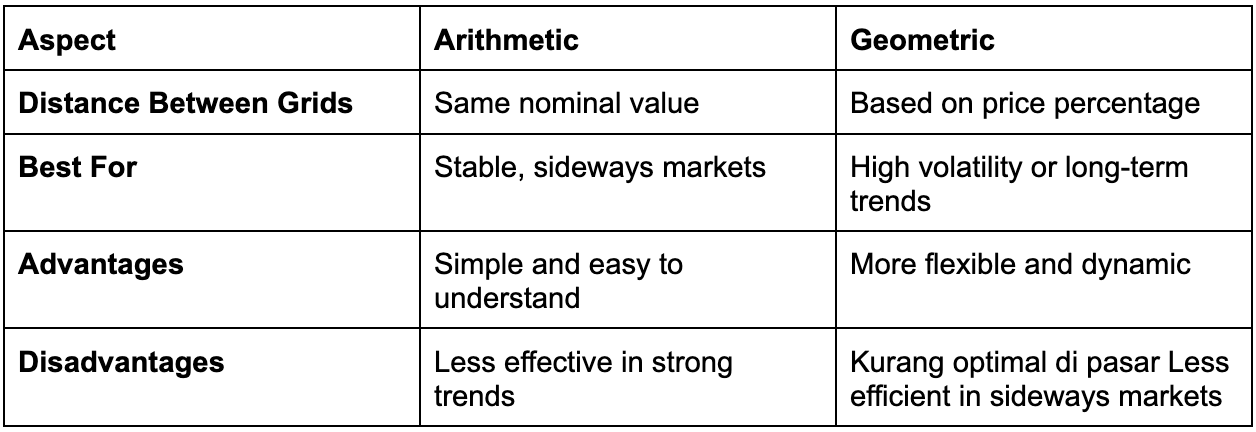.jpg)
Grid trading is a trading strategy that involves placing a series of buy and sell orders within a specific price range, regardless of the market's direction. The primary goal is to take advantage of small price fluctuations to generate consistent profits. In grid trading, there are two main approaches for setting the distance between order levels: the Geometric strategy and the Arithmetic strategy. Each has its strengths and weaknesses, depending on the market conditions and your trading objectives.
Arithmetic Strategy in Grid Trading
The Arithmetic strategy is a grid trading approach that uses equal distances between order levels. In other words, the distance between two consecutive prices (such as buy and sell orders) is a fixed nominal value, regardless of the price position.
Example:
If you choose a price range between $100 and $200 with 5 grids, the distance between each level will always be the same, i.e., $20 ($100, $120, $140, $160, $180, $200).
Advantages of Arithmetic:
- Easy to understand and implement: The approach is simple and easy for beginners.
- Ideal for stable markets: More effective when prices move within a narrow range or sideways.
- Even distribution: Helps place buy and sell orders consistently.
Disadvantages of Arithmetic:
- Not flexible for high volatility: When the market moves quickly or experiences large fluctuations, this model may be less effective.
- Not ideal for trending markets: Fixed distances can reduce opportunities when the market moves in a strong trend, either up or down.
Read more: What Is Spot Grid Trading and How Does It Work?
Geometric Strategy in Grid Trading
Unlike Arithmetic, the Geometric strategy uses the distance between levels based on a fixed percentage. With this approach, more orders are placed at lower prices, and the distance between orders increases as the price rises.
Example:
If the price range is from $100 to $200 with a 5% increase per step, the grid will be positioned as follows: $100, $105, $110.25, $115.76, and so on.
Advantages of Geometric:
- More adaptable to market volatility: Geometric is suitable for markets with high fluctuations or strong trends because the distance between levels adjusts with price changes.
- Ideal for growing markets or long-term trends: It maximizes profit potential when prices are rising.
- Flexible distribution: Places more buy orders at lower prices, allowing traders to purchase more assets when prices fall.
Disadvantages of Geometric:
- Less effective in sideways markets: If the market moves steadily without large fluctuations, many orders may not be executed.
- More complex in calculation: Requires more analysis to determine the right percentage for each grid step.
Key Differences Between Arithmetic and Geometric

When to Use Each Strategy?
Arithmetic Grid: Use this strategy if your market is stable or moves within a narrow price range (sideways). It's ideal for traders who prefer a simple and more predictable approach.
Geometric Grid: Choose this strategy when the market shows high volatility or a strong trend, as the distance between levels follows the market movement, allowing you to capture larger profits when prices rise.
Read more: Annual ROI Simulation from Spot Grid Trading Strategy
Conclusion
Both the Arithmetic and Geometric strategies have their advantages and disadvantages. The choice of strategy largely depends on market conditions and your trading goals. If you want to focus on a stable market and need a simpler approach, the Arithmetic strategy might be more suitable. However, if you're dealing with a dynamic market with significant fluctuations, the Geometric strategy offers greater flexibility and higher profit potential.
To maximize your potential return in grid trading, it's essential to continually evaluate your strategy in response to changing market conditions. Ensure that you select a strategy that aligns with your risk profile and trading objectives.
Do you want to dive deeper into Spot Grid Trading? You can click here to explore the full guide in our Help Center. Interested in trying out grid trading for yourself? Download the Mobee app now and start exploring the opportunities in the cryptocurrency market today!












%201.png)


